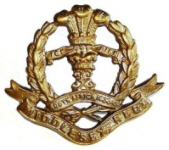



No.F/3318, Private, Arthur Thomas FLACK
Aged 27

|
Arthur Thomas Flack was born in Fen Ditton in 1889 (Chesterton Q4-1889 3B:459) baptised Fen Ditton on 1st November 1889, son of James and Emily Grace
FLACK(née PRECIOUS).
1891 census...Aged 1, he was at Mill Road, Bottisham with his Father James FLACK [26] a farm labourer, born Stow cum Quy; his mother Emily [30] born Great Wilbraham and brother Leonard [4] born Stow cum Quy. His father died in 1895. 1901 census...Aged 10 and recorded as born in Woodditton, he was in the Workhouse in Newmarket with his mother and a sister Emily L [7] born Lode. His mother re married in 1908 to Swaffham Bulbeck born Frederick RAND (previously married to Edith BRETT (1849-1899). 1911 census...Aged 21, farm labourer, he was with his grandparents John [69] horseman (born Quy), and Charlotte [67] (born Quy) FLACK at The Reading Room, Stow cum Quy. His mother, now Emily Grace RAND was visiting Thomas and Louisa BAREFORD at High Street, Swaffham Prior, she died in 1912. Emily was recorded as married but Frederick RAND has not been identified in this census. Arthur married in Bottisham on 11th February 1912 to Ethel May ROLFE.(b.11-9-1893) They had three children, Ada Emily 20-4-1912, Arthur Leonard 4-2-1914 and Donald William 6-1-1916 |

|
He enlisted in Bury St Edmunds on 11th December 1915. He gave his age as 26 years 2 months, a farm labourer, address Bottisham, weighed 108 lbs
(49.1 kg), was 5ft 3
ins (160 cm)tall and chest 34" to 36" (86.4 to 91.4 cm), Church of England. Married to Ethel May, and had 3 children. He was mobilised on 10th April 1916 in the 27th Battalion, Middlesex Regiment and posted to the B.E.F. on 27th August 1916. Joining his unit, "C" Coy., 23rd (Service) Battalion, Middlesex Regiment, in the field 18th September 1916. He suffered gun shot wounds to the neck on 7th June 1917, was taken via 4 London Field Ambulance to No 12 C.C.S. at Proven where he died at 13:30 on 8th June. The 23rd were the 2nd Footballers Battalion. When war broke out there was an public outcry as Rugby and Cricket scrapped their fixtures, but Soccer carried on. Then William Joynson-Hicks formed a battalion on 12 December 1914 at Fulham Town Hall after Lord Kitchener suggested it as part of the Pals battalion scheme. England international Frank Buckley became the first player to join, one of thirty players who signed up at its formation.The formation was announced to the general public on 1 January 1915. During Army training, the players were allowed leave on a Saturday to return to their clubs to take part in games. However, the clubs found themselves having to subsidise the train fares as the Army did not pay for them. That battalion was the 17th (Service) Battalion, Middlesex regiment. In June 1915 the 2nd footballers battalion was raised, the 23rd (Service) Battalion, Middlesex Regiment. They not only recruited footballers but encouraged supporters to join and fight along side their heroes, who included Walter Tull, not only the first black outfield player in League football, but the first officer in the Army not to be of white European stock. The 23rd Middlesex arrived on the Western Front in May 1916 and went into the line near Le Touquet. In August they moved south to the Somme, where they participated in the attack at Flers (the first occasion on which tanks appeared on the battlefield), suffering heavy casualties. On 7 June 1917 the 23rd Middlesex were involved in the attack at Messines, a few miles south of Ypres. Four days later, when the Battalion left the front line, only 8 officers and 298 other ranks had not become casualties. 40 of the 23rd Battalion were killed on the 7th.
click here to go to the Commonwealth War Graves Commission website for full cemetery/memorial details |